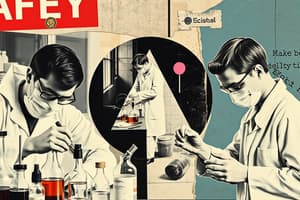Podcast
Questions and Answers
What is the first step to ensure safety in the science laboratory?
What is the first step to ensure safety in the science laboratory?
- Notify your teacher about allergies
- Learn the location of safety equipment
- Study the laboratory procedure
- Obtain your teacher’s permission to begin (correct)
Which of the following actions is NOT allowed in the laboratory?
Which of the following actions is NOT allowed in the laboratory?
- Wearing closed-toe shoes
- Eating or drinking (correct)
- Tying back long hair
- Using safety goggles
What should you do if you are unsure about the safety procedures for a specific piece of equipment?
What should you do if you are unsure about the safety procedures for a specific piece of equipment?
- Watch a video tutorial
- Try to use it anyway
- Ask your teacher for help (correct)
- Read the manual without asking
Why is it important to keep your work area uncluttered?
Why is it important to keep your work area uncluttered?
Which of the following is an example of personal protective equipment that should be used in a laboratory?
Which of the following is an example of personal protective equipment that should be used in a laboratory?
What is the proper behavior expected in the laboratory?
What is the proper behavior expected in the laboratory?
What is a key reason for tying back long hair and securing loose clothing in the lab?
What is a key reason for tying back long hair and securing loose clothing in the lab?
Which safety equipment should you know the location of in case of an emergency?
Which safety equipment should you know the location of in case of an emergency?
What should you do if your clothing catches fire in the laboratory?
What should you do if your clothing catches fire in the laboratory?
What is the primary purpose of a test tube holder?
What is the primary purpose of a test tube holder?
Which of the following actions is NOT allowed in the laboratory?
Which of the following actions is NOT allowed in the laboratory?
What should you do with broken glass and solid substances?
What should you do with broken glass and solid substances?
What should you do immediately after an injury in the lab?
What should you do immediately after an injury in the lab?
When should you wash your hands after working in the lab?
When should you wash your hands after working in the lab?
What is the purpose of a graduated cylinder in a laboratory setting?
What is the purpose of a graduated cylinder in a laboratory setting?
What is the correct action to take if chemicals come into contact with your eyes?
What is the correct action to take if chemicals come into contact with your eyes?
Flashcards are hidden until you start studying
Study Notes
General Safety Rules
- Always obtain teacher’s permission before starting investigations or using lab equipment.
- Understand the procedure and seek clarification on any safety symbols.
- Communicate allergies or health issues to the teacher for safe participation.
- Learn proper equipment use; ask the teacher if uncertain.
- NO food, drinks, or personal grooming allowed in the lab; avoid using lab glassware for food/drink.
- Be aware of the safety shower, eye wash station, fire blanket, and fire alarm locations.
Preventing Accidents
- Wear appropriate personal protective equipment: lab gown, goggles, masks, gloves.
- Do NOT use flammable hair products; secure long hair and loose clothing.
- Open-toed shoes or sandals are not permitted in the lab.
- Remove hand and wrist jewelry to prevent snagging on equipment.
- Avoid tasting substances or using your mouth to draw materials.
- Maintain proper behavior; horseplay can lead to accidents.
- Keep your workspace organized and uncluttered.
Laboratory Work Protocol
- Gather all equipment and materials before starting a lab experiment.
- Stay in your designated work area unless instructed otherwise.
- Always angle test tubes away from people while heating or adding substances.
- To smell a substance, waft vapors towards your nose from a safe distance.
- Do NOT substitute chemicals unless specifically instructed by the teacher.
- Do NOT remove any materials or chemicals from the lab.
- Limit access to storage areas to when supervised by the teacher.
Laboratory Cleanup Procedures
- Turn off burners, water, gas, and disconnect electrical devices after use.
- Clean and return all equipment and materials to designated locations.
- Dispose of chemicals per teacher’s instructions; broken glass goes in proper containers.
- Clean your workspace thoroughly.
- Wash hands with soap and water before removing goggles.
Emergency Protocols
- Report all incidents, such as fires or spills, to the teacher immediately.
- In case of clothing fire, STOP, DROP, and ROLL or use a fire blanket/safety shower.
- Turn off gas and evacuate during a fire following established procedures.
- Only the teacher should handle cleanup of spills unless permitted.
- Immediately use eyewash or flush skin/eyes with water if chemical contact occurs.
- Fire extinguisher and first-aid kit use is restricted to the teacher, unless in severe emergencies.
- Only certified personnel should administer first-aid.
Laboratory Apparatus and Their Uses
- Laboratory Apparatus: Essential tools for conducting experiments (e.g., test tubes, pipettes, beakers).
- Test Tube: Holds, mixes, and heats substances during experiments.
- Test Tube Holder: Securely holds test tubes during manipulation.
- Test Tube Rack: Keeps test tubes upright for convenience.
- Beaker: Contains and measures liquids.
- Erlenmeyer Flask: Used for mixing, heating, and storing liquids; ideal for filtration processes.
- Graduated Cylinder: Accurate measurement of liquid volumes.
- Mortar & Pestle: Used for grinding solid chemicals into finer particles.
Studying That Suits You
Use AI to generate personalized quizzes and flashcards to suit your learning preferences.




